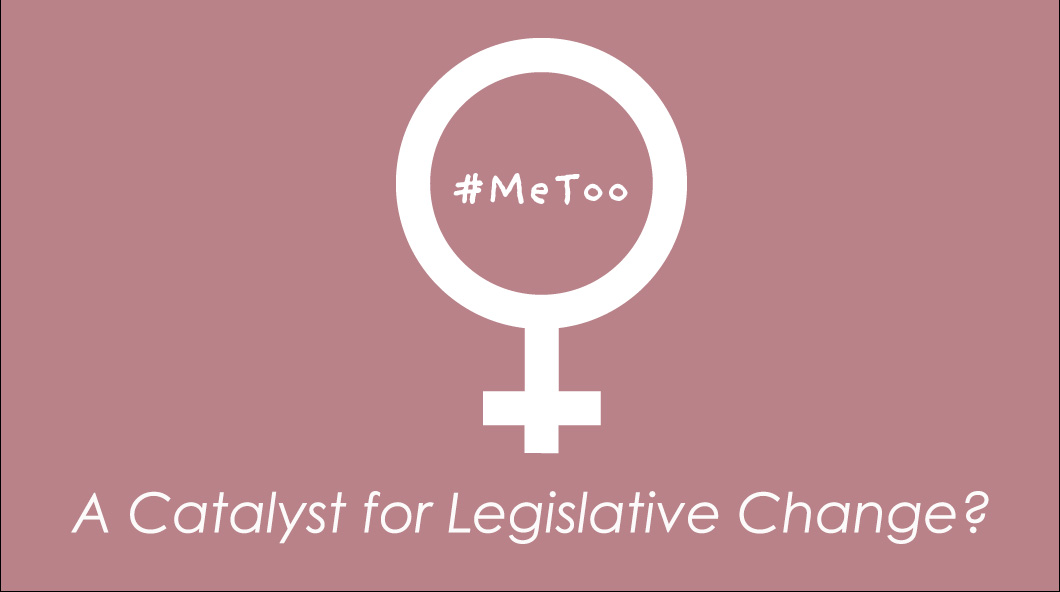[Written by Pauliina Ketonen]
[Image by Kate Zápražná]
[Trigger Warning: this article includes discussion of sexual assault.]
Scandals come and go, but in the last year, their number and media permanence has been dizzying. With reports spanning from Hollywood to the UN we are forced to acknowledge how deeply bullying, sexual harassment, and abuse are embedded in our society.
The big question, now that the #MeToo movement has reached its first anniversary, is what the long-lasting effects of it are. Is #MeToo capable of instigating large-scale legislative or policy change? What is, or ought to be, the true position of #MeToo in society, moving forward? In order to answer these questions, it is necessary to look to the legal system, and how it deals with sexual harassment and abuse.
The System – Then and Now
Feminist jurisprudence is a discipline which studies the relationships between gender, sexuality and power within the legal system. It has contributed greatly to conversations about sexual violence, domestic abuse, and gender-based harassment.
One of the guiding notions of feminist jurisprudence is that the justice system is ‘phallocentric’, i.e. “structured to meet the needs of the masculine imperative” and is thus flawed, since the narrative it supports is far too narrow to address issues based on gender, sexuality and power.
Carol Smart, a prolific writer in this field, argues that this phallocentric culture is present in legal forms of fact-finding. For instance, she argues that the way in which accounts of rape are dealt with constitutes a “disqualification of women and women’s sexuality”. The examples she uses are the strict rules on corroboration and the inclusion of a woman’s sexual history as a relevant piece of evidence in a rape trial.
Particularly corroboration, to Smart, supports the notion that the law resists alternative accounts of social reality, especially those relating to sexuality and enforces a culture in which accounts of sexual assault are held to be intrinsically unreliable.
Similar arguments are explored in Helena Kennedy’s seminal book Eve was Framed. Kennedy draws attention to how defence counsels attempt to undermine women’s experiences in court. She claims that the difference between men and women in this regard is stark, and that “[i]n discrediting men, it is rare that an attack goes to the foundations of their manliness… We may impugn them for their violence, neglect or greed … but none of them would be reduced in the eyes of the court for an uncommitted sexual relationship, for choosing not to marry or for failing to fulfil domestic chores.”
The criticisms both Smart and Kennedy raised in the 1980s and 1990s are still, to an extent, present in the Scottish criminal justice system. Character evidence of the victim’s sexual history is still admissible in some cases, though it is subject to strict restrictions. Corroboration remains a fundamental element of the Scottish system, which poses particular evidential issues in sexual offence cases.
However, to argue that nothing has changed and that the system remains entirely ‘phallocentric’ is false. Sexual offence legislation has been subject to significant change in both England and Scotland, the current Acts having been passed in 2003 and 2009, respectively. Both Acts emphasise sexual autonomy and consent. It is also important to note that both Acts are gender neutral – previously, only women could be victims of certain offences, presently, the victim’s gender is not relevant.
The Equality Act 2010 extends protection against discrimination and harassment to, for example, workplaces and educational facilities. Additionally, the Scottish Parliament has recently enacted the Abusive Behaviour and Sexual Harm (Scotland) Act 2016. This instructs judges on how to direct juries in sexual offence cases. It aims to tackle jury misconceptions relating to sexual offences, particularly in relation to delays in reporting and the absence of physical resistance by the victim.
The Future is Bright?
There is no doubt that #MeToo can instigate legislative change – the real question is whether it should. When governments want to jump on various bandwagons to gain more popularity, they usually enact new laws, and sometimes rush them through Parliament. While in some cases reforms are needed, enacting new laws for the sake of being able to do so is not good policy making.
The focus of law making, particularly when it concerns such complex and sensitive subject matters as bullying, harassment and assault, should be user-friendliness – meaning the laws ought to be clear and comprehensive. The current laws relating to sexual offences are gender neutral, consent-based and inclusive. Using #MeToo as a political power move to enact more legislation is not a good use of the movement’s power, or of lawmakers’ resources.
What #MeToo can, and most definitely should change, is the culture we live in. #MeToo has already changed things immensely when it comes to the culture of silence, as it has created a sense of community that has allowed people to come forward with their stories. This is where #MeToo is at its strongest – in changing the way we think about abuse and harassment, and in encouraging transparency and discussion of difficult topics. Going forward, this immense cultural impact must be seen and felt in places of power.
Making real change happen requires us to call into question the exercise and enforcement of policies beyond the reach of laws. It requires us to continue talking about bullying, harassment and abuse. The legal tools for getting justice already exist, it is their use that we must encourage and support.
Whether the fight against sexual harassment will continue to be called #MeToo, in the long run, is uncertain. What is certain, however, is that the culture of silence will no longer prevail.
[Image Description: A dusty pink background with the female sign in the middle. Inside the circle the words ‘#Metoo’ are written. Below the sign, it says: ‘A catalyst for legislative change.’]

